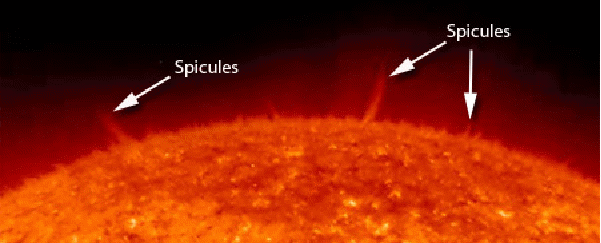The Sun's chromosphere the layer immediately above the Sun's photosphere, 2000-3000 km thick, and can only be seen during a total solar eclipse because it is much fainter than the photosphere, due to the low density of the gas it contains. Light from the chromosphere is dominated by emission lines and contains strong Balmer H-alpha emission lines at 656.3 nm in the red part of the spectrum.
Spikes of gas up to 7,000 km long called spicules enetrate the chromosphere. They are short-lived phenomena, corresponding to rising jets of gas that move upward at about 30km/sec and last only about 10 minutes.

The density of the chromosphere is only about![]() times that of thephotosphere and decreases with height above the photosphere,logarithmically from
times that of thephotosphere and decreases with height above the photosphere,logarithmically from![]() or
or ![]() to under
to under![]() at the top of the chromosphere.The temperature begins to decrease from the base from 6000K to a minimum of approximately 3,800K before increasing to about 35,000K at the top with thetransition layerof thecorona.
at the top of the chromosphere.The temperature begins to decrease from the base from 6000K to a minimum of approximately 3,800K before increasing to about 35,000K at the top with thetransition layerof thecorona.
